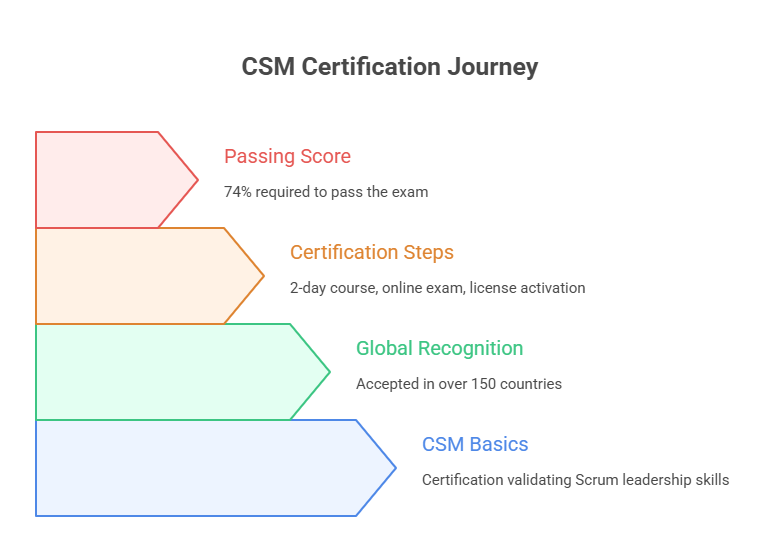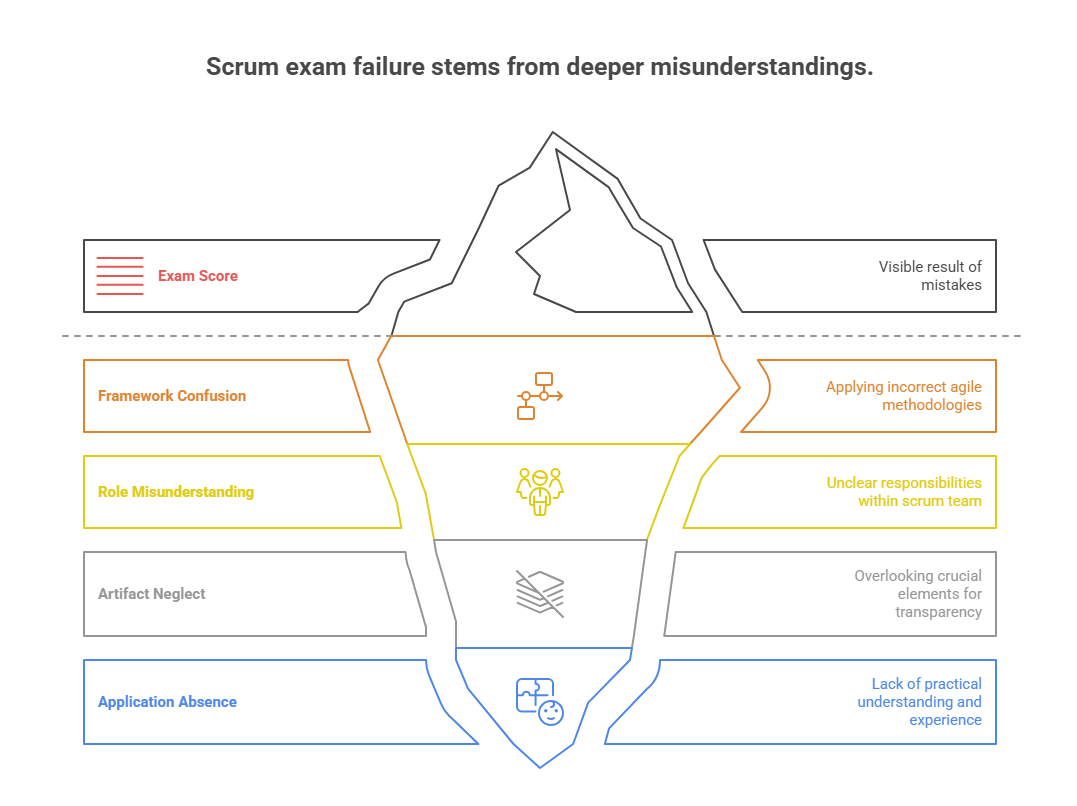Scrum Master Certification (CSM): Ultimate Guide to Passing Your Exam (2025)
The role of a Certified Scrum Master (CSM) has evolved into one of the most in-demand certifications in the project management space — especially as companies double down on agile transformation in 2025. Scrum continues to dominate software, product, and even service-based industries, making the CSM a direct path to roles that require lean, fast, and adaptive leadership.
But passing the CSM exam isn’t automatic. With more competition and tight exam standards, it takes a focused strategy, the right prep, and real-world understanding. This guide gives you exactly that — no fluff, no filler. Just what you need to know, learn, and do to earn your Scrum Master Certification confidently in 2025.
CSM Certification Breakdown
What Is CSM and Why It’s Valuable
The Certified Scrum Master (CSM) credential is more than a badge — it's a formal validation that you understand and can apply Scrum principles in real-world teams. It demonstrates that you can coach teams, facilitate daily standups, and uphold Scrum values that lead to fast, adaptive delivery.
Scrum is now used beyond tech — in marketing, operations, and education — making the CSM a cross-industry asset. It’s especially valuable for those looking to transition into Agile roles without a software background. Employers see CSM as a sign you understand team dynamics, backlog management, and sprint planning at a practical level.
CSM also builds confidence. It gives you frameworks and language to influence team workflows and stakeholder alignment — essential for Scrum adoption success.
Who Issues It and Global Recognition
The CSM is issued by Scrum Alliance, a globally recognized nonprofit organization dedicated to Agile and Scrum training. Founded in 2001, Scrum Alliance is one of the most trusted names in the Agile certification space, and its CSM credential is accepted by hiring managers in over 150+ countries.
Unlike vendor-specific certificates, the CSM doesn’t tie you to one methodology or software. That means you're gaining flexible, portable knowledge that applies across industries and team structures. Scrum Alliance also supports ongoing learning with a renewal process every two years to ensure you're staying current with evolving practices.
CSM’s popularity is also due to its robust learning experience — certification is only awarded after completing an approved course and passing the exam.
Certification Steps Overview
To earn your CSM, you’ll go through a structured process that ensures both theory and practical learning:
Enroll in a Certified ScrumMaster course offered by a Scrum Alliance-approved trainer.
Attend the two-day training, typically live online or in-person.
After completing the course, you’ll receive access to the official exam portal.
Take the CSM exam online, which consists of 50 multiple-choice questions in 60 minutes.
Score at least 37 correct answers (74%) to pass.
Once you pass, accept the license agreement and set up your Scrum Alliance profile to become officially certified.
This process ensures you're not only informed but ready to function effectively as a Scrum Master from day one.
What’s on the CSM Exam?
Scrum Framework Overview
The CSM exam revolves around your ability to apply the Scrum framework in practical scenarios. It tests how well you understand Scrum roles, events, artifacts, and guiding principles — not just definitions, but how they function in a real-world team environment.
Expect questions on:
Scrum roles (Scrum Master, Product Owner, Developers)
Sprint lifecycle: from Sprint Planning to Sprint Review
Scrum events: Daily Scrum, Sprint Retrospective, Product Backlog Refinement
Scrum artifacts: Product Backlog, Sprint Backlog, Increment
The Agile Manifesto and Scrum values
The exam assumes you understand how these pieces interact — especially your role in facilitating Scrum adoption while coaching both the team and stakeholders.
Types of Exam Questions
The CSM exam contains 50 multiple-choice questions, all to be completed in 60 minutes. These aren’t trick questions — but they are context-driven, requiring conceptual clarity. Most questions are scenario-based, testing your ability to respond in alignment with Scrum principles.
You’ll likely encounter:
“What should the Scrum Master do?” type questions
Misconceptions around command-and-control thinking
Situational conflict resolution or process improvements
Role-based actions and responsibilities
There are no negative marks for wrong answers, and questions usually have only one correct choice, though some may feel nuanced. You must read closely to understand the intent behind each option.
How Scoring Works
To pass the CSM exam, you must get at least 37 out of 50 questions correct, which equals a 74% passing score. Once you complete your two-day course with a Certified Scrum Trainer, you’ll receive a link to take the exam via Scrum Alliance.
Here’s what else to know:
The exam is open book, so you can refer to notes or guides while answering.
If you fail, you get one free retake within 90 days.
Most candidates pass on the first try, especially if they’ve reviewed core Scrum artifacts, roles, and event flows.
The scoring system is simple, but don’t confuse simplicity with ease — you'll need real conceptual clarity and practical interpretation to succeed.
Study Strategy and Tips
Key Topics to Focus On
Success on the CSM exam depends on precision, not memorization. Focus on the mechanics of the Scrum framework, but more importantly, understand why they exist. You should have crystal clarity on:
Scrum roles and their boundaries
Sprint events: purpose, participants, and timing
Scrum values: focus, courage, openness, commitment, respect
What the Scrum Master should not do (e.g., assigning tasks)
Servant leadership vs. directive control
Avoid cramming. Instead, go deep on what makes Scrum distinct from traditional project management and other Agile methods.
How to Build Real-World Understanding
CSM questions are contextual and situational, not just theoretical. The more real-world experience or case simulations you can explore, the stronger your intuition becomes. Here’s how to build applied understanding:
Study real sprint boards on tools like Jira or Trello
Watch YouTube walkthroughs of Scrum teams in action
Review case studies from companies that implemented Scrum
Participate in Agile communities on Reddit, Slack, or LinkedIn
Reflect on past team experiences — good or bad — and analyze them through a Scrum lens
Even if you haven’t worked in Agile before, simulating these environments helps your brain anticipate the exam logic with ease.
Mock Tests and Peer Learning
Practice exams are non-negotiable. They not only build retention but train your mind to spot trick phrasing and eliminate weak options. Use at least 3–4 high-quality mock tests before exam day. Look for those aligned with Scrum Alliance’s current exam blueprint.
Beyond solo prep, peer learning accelerates clarity. Join a Discord or Slack group with other CSM aspirants. Share tricky questions, debate rationale, and discuss interpretations. Teaching others is often the best indicator that you truly understand.
Here’s a 3-part approach:
Do a mock test cold.
Analyze every question you got wrong — not just the right answer, but why you misunderstood.
Teach that question to someone else.
This loop reinforces concepts better than repetition ever could.
| Focus Area | Strategy & Explanation |
|---|---|
| Key Topics | Master Scrum roles, Sprint ceremonies, servant leadership, and how artifacts support transparency and delivery. |
| Real-World Practice | Watch real sprint boards on tools like Jira, explore case studies, and visualize daily Scrum execution in a team setting. |
| Mock Exams | Attempt at least 3–4 high-quality practice tests that reflect the Scrum Alliance exam structure and style. |
| Peer Learning | Join LinkedIn groups, Discord servers, or online study forums to discuss tough concepts and explain answers to others. |
| Study Timeline | Allocate 10–15 hours post-training for review, practice exams, and gap analysis to ensure strong exam readiness. |
Common Mistakes to Avoid
Confusing Scrum with Agile
A major pitfall is assuming that Scrum and Agile are interchangeable. Agile is a broad philosophy — Scrum is one of its frameworks. If you treat the CSM exam like a generic Agile test, you'll miss critical nuances. For example, Agile encourages flexibility, but Scrum has strict roles, artifacts, and event rules.
Many fail the exam because they apply Kanban or Lean logic to Scrum scenarios. Stick to Scrum Alliance’s interpretation and don’t dilute your study with unrelated Agile practices unless directly relevant.
Overlooking Role Responsibilities
Another costly mistake is not fully understanding role boundaries. The Product Owner is not a stakeholder. The Scrum Master does not manage the team. Developers don’t report to anyone within the team structure.
Expect the exam to test whether you understand who should do what in various situations — from backlog refinement to sprint execution. Misidentifying responsibilities will cost you quick points.
Focus especially on:
Who facilitates each Scrum event
Who owns the Product Backlog
Who’s responsible for coaching the team vs. managing delivery
Clarity here often determines whether you pass or fail.
Not Reviewing Scrum Artifacts Properly
Many learners gloss over Scrum artifacts thinking they’re just documents. In reality, they’re foundational components of Scrum. The Product Backlog isn’t a wish list — it’s a living, prioritized roadmap. The Sprint Backlog isn’t just a task list — it’s a self-managed plan owned by the developers.
Expect questions around:
The purpose of each artifact
How they’re updated
Who owns them
How they ensure transparency and alignment
Don’t treat artifacts as admin work — treat them as the heartbeat of the Scrum process.
Choosing the Right CSM Prep Program
Instructor-Led vs. Self-Paced
Your success in the CSM exam hinges heavily on the training program you choose. Scrum Alliance mandates that you attend a live class with a Certified Scrum Trainer (CST), but you often get to choose between instructor-led virtual sessions or immersive in-person workshops.
Instructor-led courses provide:
Live engagement with real Scrum practitioners
Immediate feedback and hands-on activities
Direct clarification of complex exam concepts
However, self-paced content is still useful as preparation before the live class. Use recorded videos, books, and discussion forums to build context — but don’t rely on them alone to pass the exam.
Must-Have Features in Training
Not all CSM training is created equal. Since this certification is a foundational project management credential, you need a course that blends conceptual clarity with exam-specific strategies.
Look for programs that offer:
Scenario-based learning and real team simulations
Visual frameworks to reinforce Scrum roles and flows
Access to CSM practice tests and question banks
Post-course support and replays
If you're comparing the CSM to other project management certifications, such as PMP or CAPM, here’s the key difference: CSM is role-specific and highly agile-focused. It’s not about managing projects top-down — it’s about facilitating outcomes within self-organizing teams.
Choosing the right CSM program helps you not only pass the exam, but also build a skillset that aligns with modern project leadership in Agile-first organizations.
| Program Component | Details & Value |
|---|---|
| Instructor-Led Training | Offers live interaction, real-world examples, and practical group exercises with certified Scrum trainers. |
| Self-Paced Supplements | Great for pre-course learning and post-class reinforcement, but not a substitute for the mandatory live course. |
| Mock Exams & Scenarios | Look for courses that offer exam simulations and role-based scenarios that mirror CSM exam questions. |
| Trainer Experience | Choose programs led by trainers with real Agile transformation experience, not just theoretical knowledge. |
| Certification Synergy | Ideal CSM prep programs help bridge knowledge gaps for professionals with PMP/CAPM backgrounds transitioning to Agile roles. |
How Project Management Certification Helps You Master Scrum Concepts
Learning Aligned with Project Management Standards
The Certified Scrum Master (CSM) exam doesn’t require prior experience — but mastering it becomes easier if you’ve already been exposed to project management certification frameworks. Certifications like PMP, CAPM, and hybrid Agile programs reinforce skills like stakeholder communication, value-driven delivery, and iteration planning — which map directly to Scrum roles, events, and values.
Instructor-led CSM courses mirror the style of many PMI-approved training programs: live sessions, interactive simulations, and real-world case studies. If you’ve already taken a project management certification, you're likely familiar with timeboxing, cross-functional team dynamics, and servant leadership models.
This makes it easier to understand how Scrum builds on Agile principles, but executes them with strict roles and cadences.
Why Project Management Certifications Complement CSM
Project management certifications provide structure. Scrum provides speed. Together, they give you the tools to lead teams in any environment — whether it’s a 6-month waterfall plan or a 2-week sprint cycle. A PMP-certified professional transitioning into a Scrum Master role already understands scope, risk, and resource balancing — now they learn how to let go of control and empower self-organizing teams.
If you’re pursuing CSM as your first step, it’s a great entry point. But if you’re thinking longer term, pairing it with a project management certification from APMIC or PMI gives you a career edge across industries.
The overlap is real:
Scrum ceremonies = stakeholder meetings in PM
Product backlog = scope control
Definition of Done = quality assurance
If you’re serious about becoming a well-rounded Agile leader, CSM + project management certification is the smartest path forward in 2025.
Frequently Asked Questions
-
There are no formal prerequisites to take the CSM exam, but you must complete a two-day Certified ScrumMaster course from a Scrum Alliance-authorized trainer. You don’t need prior Agile or project management experience, but understanding the basics of Scrum will help you absorb the course material faster. Many candidates come from development, QA, marketing, or project coordination roles. Even complete beginners can succeed if they approach the certification with focus. The course is mandatory and grants access to the exam upon completion. This ensures all participants are trained consistently before attempting the Certified Scrum Master exam.
-
Most learners take about 1–2 weeks to prepare for the CSM exam after completing their required training. The two-day course covers all the foundational knowledge, and many candidates can pass the exam immediately afterward. However, to truly master the concepts and scenarios, it’s wise to review your notes, attempt a few mock exams, and revisit Scrum Guide principles. If you’re new to Agile, consider spending extra time understanding Scrum roles and values. In total, 10–15 focused study hours post-course is typically sufficient to pass the exam confidently.
-
Yes, the CSM exam is open book and delivered online through Scrum Alliance's exam portal. You can take it from any device with a stable internet connection. While open book sounds easier, the questions are conceptual and scenario-based, so having your notes won’t help much if your foundational understanding is weak. You’ll have 60 minutes to answer 50 multiple-choice questions, and you need a score of 74% or higher (at least 37 correct answers) to pass. There’s no proctoring or webcam requirement. If you fail, you get one free retake within 90 days.
-
The Certified Scrum Master (CSM) focuses exclusively on Scrum and Agile team facilitation, while PMP and CAPM emphasize predictive project management and broader project lifecycle control. PMP requires thousands of hours of project experience, whereas CSM is beginner-friendly and more accessible. If you're entering tech or agile teams, CSM is often the faster, more practical entry point. However, PMP is preferred for traditional enterprise project roles. CSM is also far more role-specific — it’s tailored for Scrum Masters working in self-organizing Agile teams, not project managers directing end-to-end delivery.
-
Yes, CSM certification must be renewed every two years through Scrum Alliance. The renewal requires you to earn 20 Scrum Education Units (SEUs) and pay a $100 renewal fee. SEUs can be earned by attending events, taking additional courses, or participating in Agile community activities. This renewal ensures that certified Scrum Masters stay current with best practices and evolving methodologies. Unlike one-time credentials, Scrum Alliance encourages ongoing learning, making the CSM a continuously maintained certification. You’ll receive renewal reminders ahead of your expiration date to help you stay compliant.
-
Absolutely. In fact, many Scrum Masters come from non-technical backgrounds such as HR, marketing, or customer service. Scrum is not a coding framework — it’s a team coordination and delivery framework. Your ability to facilitate, remove blockers, and promote team collaboration is far more critical than technical know-how. The CSM course and exam are designed to support both technical and non-technical professionals equally. However, if you're working in a tech company, learning basic Agile software terms and tools (like Jira or Trello) can enhance your credibility and impact.
-
The most effective way to prepare post-training is to take mock exams that mimic the real CSM test format. Focus especially on scenario-based questions and role clarity. Use your course materials to revisit Scrum artifacts, event cadences, and role boundaries. Try explaining Scrum roles and sprints to a peer — teaching is a powerful retention method. Engage in online study groups or LinkedIn forums to discuss tricky questions and exam tips. Also, review any class recording or slide decks provided. Aim for a score of 90%+ on practice tests before sitting for the real one.
Our Verdict
The Certified Scrum Master (CSM) remains one of the most targeted, role-specific certifications in Agile — and in 2025, its value has only grown. Whether you’re entering the job market, pivoting into Agile roles, or already managing projects, CSM equips you with practical leadership tools that elevate how modern teams operate.
Unlike traditional project management certifications, CSM sharpens your ability to facilitate change, unblock teams, and drive continuous delivery — all without heavy documentation or command-control structures. It’s not just about knowing Scrum — it’s about becoming someone who embodies its values.
If you're ready to lead with clarity, adapt at speed, and make an impact inside agile-first organizations, the Scrum Master Certification is the foundation your career needs. Start with CSM — then scale with strategy.
| Choose one: |




